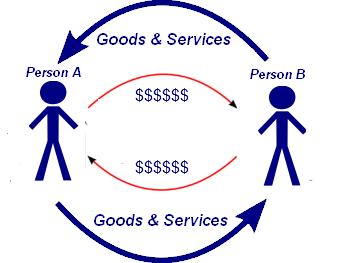|

Person A makes
Whatchama-callits, which he sells for $1 each |
 |

Person B makes
Thinga-mabobs, which he sells for $1 eadh |
Exchange of Money:
So we have two people and $1. Now, lets look at the
exchange of money for goods.
1. Since Person A and Person B are the ONLY two in this
simplified economic system, they sell and buy from each
other. A sells Whatchamacallits to B and buys
Thingamabobs from B, and vice versa. So what goes
around comes around (money and goods) between just two
imaginary people.
2. Let's say there is only $1 available in this closed
economy, and Person A has it. Person B has no money
but does have thingamabobs to sell. So Person A buys a
Thingamabob from Person B. Now Person B has $1 and
person A has no money.
3. But since Person Be has $1, Person B now spends the $1 to
buy a Whatchamacallit from Person A. Now Person B has
no money but Person A has $1. This is cash flow, not
unlike the story about the cobbler and his wife above.
Rate of exchange of money (cash flow): So far so
good, but we now need to look at the rate of cash flow: Why?
Because, while there is only $1 in this little closed
economy we're using for our example, that does not limit how
much Person A and Person B earns. We need to know how
fast they exchange that $1.
Slow rate: Person A and Person B buy from each other
once a day. Given there are 365 days in a year, this
means they each earn $365/year.
Fast rate: Person A and Person B buy from each other
100 times a day. Given there are 365 days in a year,
this means they each earn $36,500/year.
Conclusion: Even though there is only $1 in this
example, how much Person A and B earn depends on how fast
the money exchanges hands.
In other words, what does around comes around, and the
faster it goes around, the more people benefit.
 To
read about the affect of money supply on the economy
To
read about the affect of money supply on the economy
 To
go to the Articles Page
To
go to the Articles Page

